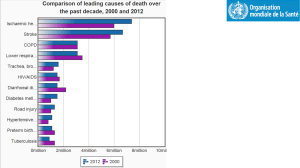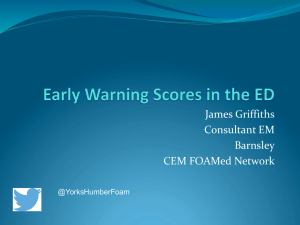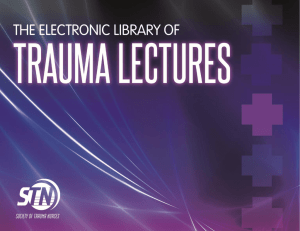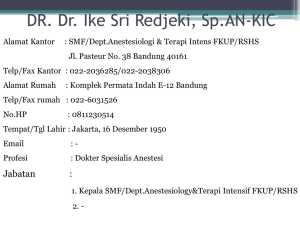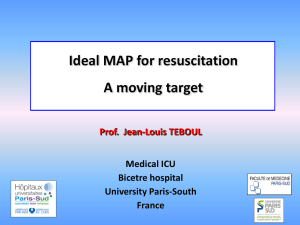MAP - SRLF
advertisement
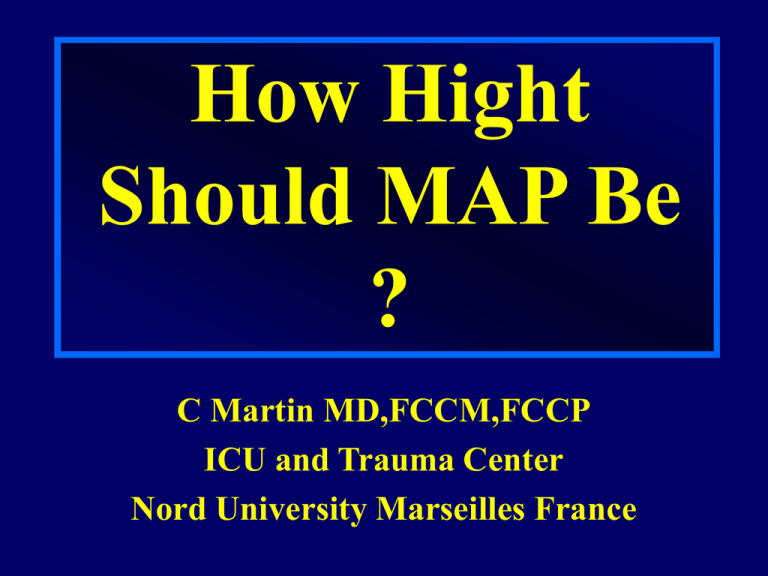
How Hight Should MAP Be ? C Martin MD,FCCM,FCCP ICU and Trauma Center Nord University Marseilles France 150 Organ Blood Flow Autoregulation (% baseline) 100 in Health and Disease Autoregulatory threshold •Below their autoregulatory thresholds, organ flows are linearly dependent on perfusion pressure. 50 Subautoregulatory slope 0 20 40 60 80 Organ Artery Pressure (mmHg) 100 What about settings where organ autoregulation is lost ? 150 Organ Blood Flow (% baseline) Autoregulation in Disease Control 3 weeks 100 1 week 50 0 20 40 60 80 100 Organ Artery Pressure (mmH g) Any increase in organ perfusion is likely to augment organ blood flow 150 Organ Blood Flow (% baseline) Autoregulation in Disease Control 3 weeks 100 1 week 50 0 20 40 60 80 Ogan Artery Pressure (mmH g) 100 Norepinephrine and Regional Blood Flow during Hyperdynamic Sepsis Merino ewes IV bolus of E. coli (3x109) Norepinephrine 0.4 g/kg/min or placebo MAP (mmHg) 87+7 (p < 0.05) CO L/min 8 + 0.8 (p<0.05 ) 7.2+12 69+8 Placebo NE Placebo NE Giantomasso ICM 2004 Norepinephrine and Regional Blood Flow during Hyperdynamic Sepsis CrCL mlL/min UF (ml/h) 83 + 54 (p<0.05 ) 117+101 p < 0.05) 41+30 52+23 Placebo NE Placebo NE Giantomasso ICM 2004 What is the relevance of these experimental studies to clinical practice ??? Norepinephrine and Renal Blood Flow MAPressure Urine Flow ml/h Time Desjars CCM 1983, 1987 Meadows CCM 1988 Time Hesselvik CCM 1989 Martin CCM 1990 Martin Chest 1994 ………. Norepinephrine in Septic and NonSeptic Patients Septic shock Creatinine Cr CL 300+137 180+110 p < 0.05 before Creatinine 100+27 before 0.7 + 0.3 24hr before Head trauma 107+17 24hr 1.7+0.9 p < 0.05 24hr Cr CL 2.8+0.7 before 2.7+ 0.6 24hr Albanese et al Chest 2004,126,534-539 MAP : 65-75-85 mmHg ??? 150 Organl Blood Flow (% baseline) Autoregulation in Disease Control 3 weeks 1 week 100 50 0 20 40 60 80 100 Organ Artery Pressure (mmH g) 150 Organ Blood Flow (% baseline) Autoregulation in Disease Control 3 weeks 1 week 100 50 0 20 40 60 80 100 Organ Artery Pressure (mmH g) 150 Organ Blood Flow (% baseline) Autoregulation in Disease Control 3 weeks 1 week 100 50 0 20 40 60 80 100 Organ Artery Pressure (mmH g) * 5,6 5,4 * Increasing MAP ? 5,2 5 CI 4,8 CI 10 septic shock patients treated by NE * 720 4,6 700 4,4 680 4,2 MAP 65 MAP 75 MAP 85 DO2 660 640 DO2 620 160 600 140 VO2 120 100 80 580 560 MAP 65 MAP 75 MAP 85 VO2 60 •LeDoux et al Crit Care Med 2000 , 28 , 2729 40 20 0 MAP 65 MA 75 MAP 85 •Increasing MAP ? 60 50 •10 septic shock patients treated by NE 40 30 UF Urine flow 18 20 16 14 10 12 0 MAP 65 MAP 75 MAP 85 10 Pa-PiCo2 8 0,45 6 0,4 4 0,35 2 0,3 0 MAP 65 0,25 MAP 75 MAP 85 Red cell velocity 0,2 0,15 •LeDoux et al Crit Care Med 2000 , 28 , 2729 0,1 0,05 0 MAP 65 MAP 75 MAP 85 65 85 Lactate Increasing MAP ? 65 DO2 85 VO2 A Bourgoin et al CCM 2005,33,780-786 UF 65 Creatinine Increasing MAP ? 85 Cr Cl A Bourgoin et al CCM 2005,33,780-786 MAP : 65 mmHg Unresolved issues : Formerly hypertensive patients ? Elderly patients ? Atherosclerotic patients ? Others ???? Coronary Artery flow Cardiogenic Shock Management of Hypotension SBP > 90 mmHg CI > 2 -1 -2 l.min .m ESC Guidelines. Eur Heart J 2005, 26,384-416 Prehospital Hypotension and Outcome in Trauma Arbabi et al J Trauma 2004 , 56 1029 70 Mortality 60 • Register of Ann Arbor Seattle USA • 19 409 patients • 2373 hypotension Blunt 50 Penetrating 40 30 20 10 0 120 + 120-90 90-60 60-0 SAP Prehospital Hypotension = Predictive Factor of Mortality in Trauma Uncontrolled Hemorrhage : Is Normal Blood Pressure the Target ? Roberts et al Lancet 2001 Bleeding or Re-bleeding Mechanic effect on vascular clot SAP Increase Agressive Volume Loading Hemodilution Anemia Hypothermia Hypoxemia Coagulation disorders Normal blood pressure is not the target ! Is Normalisation of blood Pressure Dangerous ????? • Fluid resuscitation interferes with the physiological response to hemorrhage • Elevated blood pressure favors bleeding by a mechanical effect • Hemodilution aggavates bleeding Bickell et al NEJM 1994 The effect of vigorous fluid resuscitation in uncontrolled hemorrhagic shock after massive splenic injury Solomonov E , Krausz M CRIT CARE MED 2000;28:749-754 Uncontrolled Hemorrhage in Rats MAP Survival No fluids No fluids LVNS LVNS After FR ( LVNS ) : Fall of BP , increase in blood losses and mortality Should We Raise Blood Pressure in Case of Uncontrolled Hemorrhage ????? Kwan I, Bunn F, Roberts I; WHO Pre-Hospital Trauma Care Steering Committee Cochrane group 2003. • Meta-analysis of clinical randomized studies – 3 studies on survival – 2 studies on coagulation • Maximal heterogeneity Timing and volume of fluid administration for patients with bleeding Kwan I, Bunn F, Roberts I; WHO Pre-Hospital Trauma Care Steering Committee Cochrane group 2003. found no evidence from randomised controlled trials for or against early or larger volume of intravenous fluid administration in uncontrolled haemorrhage. There is continuing uncertainty about the best fluid administration strategy in bleeding trauma patients. Further randomised controlled trials are needed to establish the most effective fluid resuscitation strategy » 1. « We Should We Raise Blood Pressure in Case of Uncontrolled Hemorrhage ????? Kwan I, Bunn F, Roberts I; WHO Pre-Hospital Trauma Care Steering Committee Cochrane group 2003. • Meta-analysis of clinical randomized studies – 3 studies on survival – 2 studies on coagulation • Maximal heterogeneity ==> No conclusion !!!!! ==> Experimental data Uncontrolled hemorrhage and fluid resuscitation with HSS+HEA or LR in Rats Burris et Col J Trauma 1999 REBLEEDING Permissive hypotension rather than the type of fluid reduces re bleeding Fluid Resuscitation Permissive Hypotension and Hemorrhagic Shock Mortality (%) and level of MAP 100% 50% 0% 40 mmHg 1 602mmHg 80 3 mmHg Stern et al Ann Emerg Med 1993 Fluid Resuscitation Permissive Hypotension and Hemorrhagic Shock Burris et al J Trauma 1999; 46 : 216-23 Aortotomy (rat) MAP 80 mmHg Su rvival (%) 80 70 60 50 40 30 20 10 0 MAP 40 mmHg MAP 100 mmHg NONE 1 2 3 4 Improved Outcome with Hypotensive Resuscitation ? Uncontrolled Hemorrhagic shock in a Swine Model Kowalenko T , et Al J. Trauma , 33 , 349 , 1992 % Survival 100 •• •• •• •• • • • •• • MAP = 40 mmHg MAP = 80 mmHg NO RESUSCITATION Time ( min ) 24 immature swines - Aortotomy - Saline Infusion Normotensive or hypotensive resuscitation ? A meta analysis • 9 randomized studies • Improvement • Pooled Risk ratio : 0.37 (0.27 - 0.52) Mapstone J, Roberts I, Evans PH , J TRAUMA 2003, 55 , 571 Favour hypotensive Favour normotensive Permissive hypotension improve survival ! Immediate Versus Delayed Fluid Resuscitation for Hypotensive Patients with Penetrating Torso Injuries Bickell WH, Wall MJ, N. Engl. J. Med. 1994 , 331, 1105 - 9 . 598 patients with torso or cervical injury . SAP ≤ 90 mmHg at the scene . No fluid survival 70 % . Fluid at the scene survival 62 % * p < 0.04 (level I) Must We Perform Vascular Loading in Multiple Trauma Patients ? Hemorrhagic shock (rat) Capone et al J Am Coll Surg 1995; 180 : 49-5 A = « prehospital » period (1 hour) B = « hospital period (72 h) 60 Group 1 : 0 VL 50 Group 2 : A = No VL ; B = VL for MAP = 80 mmHg 40 3-D Survival 30 (%) 20 Group 3 : A = VL for MAP = 40 mmHg ; B MAP = 80 mmHg 10 0 1 2 3 4 Group 4 : A = VL for MAP = 80 mmHg ; B = MAP=80 mmHg Hypotensive Resuscitation during Active Hemorrhage: Impact on In-Hospital Mortality Dutton R, Mackenzie CF , et Al J trauma 2002 , 52, 1141 • Clinical study at Trauma Centrer arrival • SBP ≤ 90 mmHg and uncontrolled hemorrhage • Randomisation: • SBP 100 (n = 55) SBP 70 (n = 55) • Survival 92.7 % in each group Penetrating Trauma and Hemorrhagic Shock A military Point of View • Fluid for – Radial pulse • SBP # 80 mmHg – If impossible, carotide pulse • SBP # 60 mmHg • Or keep the patients conscious !!!! American Armed Forces Medical Services Combat Fluids Conference July 2001 Permissive Hypotension for Uncontrollde Hemorrhage • Strong clinical arguments • Less clinical evidences • Indirect arguments – SBP : 70-90 mmhg Hypotension and Prognosis in Head Trauma Patients The role of secondary brain injury in determining outcome from severe head injury Chesnut et al J Trauma 1993, 34 : 216-22 Prospective study in 717 severe brain trauma patients SBP < 90 mmHg MORTALITY x 3 (level III) Fluid resuscitation of patients with multiple injuries and severe closed head injury Experience with an aggressive fluid resuscitation strategy York et al J Trauma 2000; 48 : 376-80 • 34 patients ISS> 16 •CGS < 8 •PPC > 80 mmHg, 74 % of patients with no cerebral sequellae 6 % mortality Hemorrhagic Shock Goals for Blood Pressure • SBP : 70-90 mmHg if no head trauma (modulate according to age and underlying disease) . MAP : 40 mmHg until bleeding is controlled and then 80 mmHg • SBP : 120 mmHg in case of head and / or medullar trauma How High Should M(S)AP Be ? Septic shock MAP : 65 mmHg 1 controlled study (30 patients) 1 open study (10 patients) Cardiogenic shock SAP : > 90-100mmHg expert opinion Hemorrhagic shock SBP : 70-90 mmHg MAP : 40 mmHg in case of TBI : SBP 120 mmHg expert opinion THE END Vasoconstrictor Effets in Hemorrhagic Shock From De La Coussaye Vasoconstrictors Venous bed Arterial bed Edema ? Increased blood pressure Increased venous return with less volume loading Increased preload Prehospital volume loading and vasoconstrictors for severe trauma SBP < 90mmHg Penetrating injury Target: SBP = 70 90 + Stop volume loading Volume loading Crystalloids Colloids < 20 ml/kg SBP unstable or target non reached Vasoconstrictor Blunt trauma + TBI GCS < 8 Target: SBP = 120, Ht = 30% + Stop volume loading First priority surgical hemostasis Transport and direct admission to trauma center From Carli P, 2005 Hemorrhagic Shock Hypovolemia Hemorrhage Surgery Vascular loading ? Transfusion ? Vasoplegia Vasopressors ? Myocardial Depression Inotropic support ? Meta- analysis of Fluid Challenge on Survival in Rat Tail resection Section ≤ 50% Favour fluids Favour NO fluids 2.88 (1.72 -1.80) Section ≥ 50% 0.25 (0.15 - 0.42) 0.86 (0.63 -1.18) Roberts I et Al, BMJ 2002 324, 474 Animal models and Uncontrollded Hemorrhage Literature Analysis Mapstone J, Roberts I, Evans PH , J TRAUMA 2003, 55 , 571 Large Heterogeneity: Stratification by Model and Severity 44 experimental studies Model Aortotomy Organ Injury Massive Hemorrhage: Fluid resuscitation improves the mortality rate Adjusted Risk Ratio 0.48 < 0.001 (0.33 - 0.71) 0.76 0.229 (0.49 - 1.18) Tail resection 0.69 > 50 % (0.38 1.25) Tail resection 1.86 < 50 % (1.13 - 3.07) Other vascular Injury p 0.221 0.015 1.70 (1.01 2.85) 0.046 Moderate Hemorrhage : Fluid resuscitation worsens the mortality rate FAUT IL CORRIGER LA PRESSION ARTERIELLE A LA PHASE AIGUE DU CHOC HEMORRAGIQUE ?? Occult hypoperfusion is associated with increased morbidity in patients undergoing early femur fixation Crowl et al J Trauma 2000, 48 : 260-7 • 57 Adultes avec fracture(s) fémorale(s) nécessitant ostéosynthèse Groupe 1 : 20 patients avec lactate < 2,5 Groupe 2 : 37 patients avec lactate > 2,5 (hypoperfusion occulte) Score de gravité identique • Complications post opératoires : Groupe 1 : 20 % Groupe 2 : 50 % Norepinephrine and Renal Flow (Endotoxemic Dogs) * * * PA (mmHg) * Qr/ml/min cont NE endo Endo + NE cont NE endo Endo + NE * CO cont NE endo Endo + NE * RVR (dynes) * cont NE endo Endo + NE Bellomo et al AJRCCM, 1999, 159, 1186-1192 Cardiogenic Shock : Management of Hypotension Use Norepinephrine to raise SBP > 80 mmHg Change to dopamine (5-15 mcg/kg/min) Dobutamine may be given when SBP > 90 mmHg ACC/AHA Guidelines 2004 Norepinephrine and Regional Blood Flow in the Normal Mammalian Circulation UF (ml/h) Cr CL ml/min 491+360 90+12 (p<0.05 ) 61+18 91+17 Placebo NE (p<0.05 ) Placebo NE Giantomasso ICM 2004 Norepinephrine and Regional Blood Flow in the Normal Mammalian Circulation MAP (mmHg) 4.78 (p<0.05) 104 (p< 0.05) CO L/min 3.76 84 Placebo NE Placebo NE Merino ewes Placebo or NE : 0.4 g/kg/min Giantomasso ICM 2004
